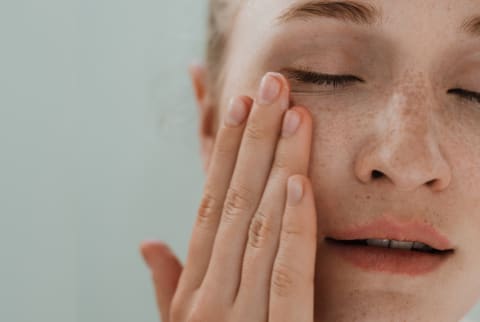Here's How To Tend To Your Skin Pre- and Post-Microneedling Treatment


Hi-tech beauty treatments are becoming more and more home-friendly: at-home massage tools, facial steamers, even microcurrent muscle therapy. And let's say upfront: We love how accessible these methods are becoming.
But some things truly should be left to the professionals. One in particular: microneedling.
This powerful procedure has some really great benefits—but it also comes with an intense device, cleaning process, and overall risk of infection. For this reason, we recommend always opting for a professional microneedling treatment. Not only will it be safer overall, but an expert will use a more potent professional-level tool, making it worth the trip.
That being said, you can and should tend to your skin at home pre- and-post-microneedling treatment; in fact, it's a very important part of the process. Below, we spoke to experts about how to prep your skin for treatment and take care of it post-procedure, so you can maximize those results.
Benefits of microneedling.
Microneedling is essentially the process of pricking the skin with tiny, sterilized needles. Some of the benefits include:
- Minimizing pore size
- Fading acne scars
- Softening fine lines
- Increasing efficacy of topicals
- Rejuvenating the skin
Many microneedling treatments now include radiofrequency as well, using red light to speed up healing and stimulate collagen production, thus encouraging healthy skin aging. These devices also have a blue light setting used to kill bacteria and treat acne. Most notably, the Vivace radiofrequency treatment combines the power of microneedling and LED light therapy for both immediate and lasting results.
"On a short-term basis, it plumps the skin and makes the skin look more radiant from inflammation and very superficial swelling. As my over 10 years of research has shown, you must combine microneedles with radiofrequency to get long-term wrinkle and scar reductions and improvements in skin quality. This approach makes a bigger difference for someone in their 30s and up," board-certified dermatologist Macrene Alexiades, M.D., Ph.D., tells mbg.
How to prepare for a treatment.
Although your practitioner will acutely prep your skin for the treatment in-office (numbing cream included, of course), there are some ways you can alter your skin care routine a few days prior in order to make the process easier on your skin.
First up: "You should stop using retinol or vitamin C products a few days leading up to the treatment," says dermatological surgeon Howard Sobel, M.D., founder of Sobel Skin Rx. Keep your routine simple, and focus on hydration. Think gentle cleanser, hydrating serums, and cushiony moisturizer.
When you do go in for your treatment, you want your skin to be as hydrated as possible and free of any active ingredients (that means no retinoids, AHAs/BHAs, and vitamin C). In addition, you'll want to plan ahead: Make sure you schedule a microneedling treatment with a few days of recovery time added to your schedule. This means no makeup, sweating, or direct sunlight.
Post-treatment care.
That simple routine we mentioned matters even more post-treatment. Your skin is essentially facing open wounds and should be treated as such. Here are a few things to keep in mind:
Avoid harsh ingredients.
Lay off any chemical exfoliants (think salicylic acid, glycolic acid, etc.) and vitamin C serums. If you're using retinol or any retinoids, put a hold on those for at least a week after your procedure as well. "Each individual varies with skin sensitivity, but for the most part, a week is a safe bet," Zahra Hashemian, medical aesthetician at Sobel Skin Rx, tells mbg.
These are general guidelines, but the most important thing is to listen to your skin. If you try to add in some exfoliation a week after your treatment and find that your skin is still sensitive, just wait a few more days to be safe.
Lock in moisture for ultimate healing.
Additionally, you'll want to stick to hydrating actives (like hyaluronic acid) and gentle moisturizers. "Microneedling may cause light skin peeling (like a sunburn) that will not last long," Sobel warns. In order to avoid excessive dryness, use an occlusive moisturizer as your final step for the first few days post-procedure. We love Pipette's Baby Balm for this, as it's a petrolatum-free healing balm.
Keep your skin & space clean.
Since there is an increased risk of infection, you'll want to be sure to use clean towels, sleep on a freshly washed pillowcase, and avoid touching your face with dirty hands. We repeat: You're dealing with tiny, open wounds here.
The takeaway.
If you're considering a microneedling treatment, be sure to plan ahead, as you'll want to have some time for your skin to recover. Stick to a simple, hydrating routine a few days before and after your treatment to ensure you get the best results without irritation. Keep your face, towels, sheets, and hands clean in order to avoid infection. As always, listen to the professionals and your own skin, as that's the key to keeping your skin healthy longer.

Hannah Frye is the Assistant Beauty & Health Editor at mindbodygreen. She has a B.S. in journalism and a minor in women’s, gender, and queer studies from California Polytechnic State University, San Luis Obispo. Hannah has written across lifestyle sections including skin care, women’s health, mental health, sustainability, social media trends, and more. She previously interned for Almost 30, a top-rated health and wellness podcast. In her current role, Hannah reports on the latest beauty trends and innovations, women’s health research, brain health news, and plenty more.
-v1646695196476.jpg?1148x800)
-v1646695196476.jpg?1148x800)